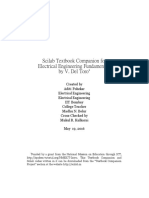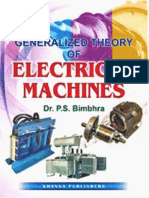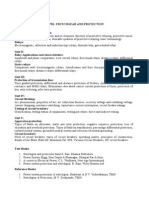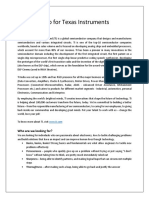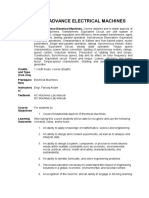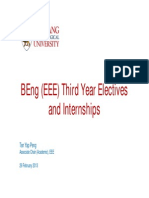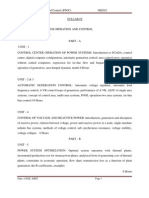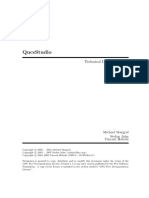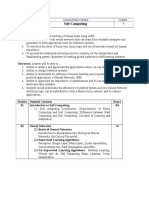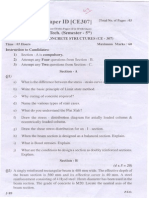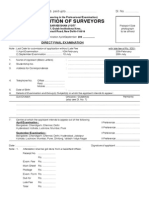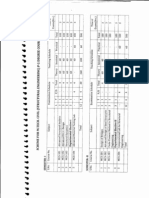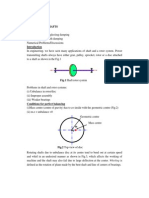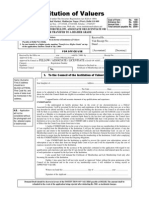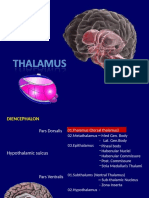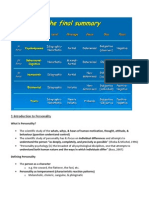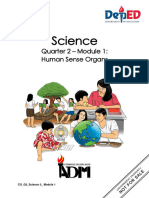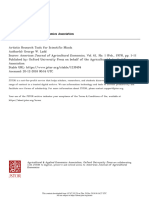COURSE FILE
GEOSYNTHETICS ENGINEERING
[CE-414E]
Prepared By:
GOURAV DUREJA
ASSISTANT PROFESSOR
DEPARTMENT OF CIVIL
MMGI, RAMBHA, KARNAL
�CONTENTS OF COURSE FILE:
Time Table
Syllabus
Lecture Plan
Course Coverage Plan (Date-Wise)
Tutorial Sheet
Evaluation Criteria
Question Papers
Subject Notes
�Neural Networks & Fuzzy Logic
CSE-402
LTP
41-
Theory: 100
Sessional: 50
UNIT 1
Introduction: Concepts of neural networks, Characteristics of Neural Networks,
Historical Perspective, and Applications of Neural Networks.
Fundamentals of Neural Networks: The biological prototype, Neuron concept, Single
layer Neural Networks, Multi-Layer Neural Networks, terminology, Notation and
representation of Neural Networks, Training of Artificial Neural Networks.
Representation of perceptron and issues, perceptron learning and training, Classification,
linear Separability.
Unit 2
Hopfield nets: Structure, training, and applications, Stability Back propagation: Concept,
Applications, and Back Propagation Training Algorithms.
Counter Propagation Networks: Kohonan Network, Grossberg Layer & Training,
applications of counter propagation, Image classification.
UNIT 3
Bi-directional Associative Memories: Structure, retrieving a stored association,
encoding associations, memory capacity.
ART: ART architecture, ART classification operation, ART implementation, and
characteristics of ART.
Image Compression Using ART
UNIT 4
Optical Neural Networks: Vector Matrix Multipliers, Hop field net using Electro optical
matrix multipliers, Holographic correlator, Optical Hopfield net using Volume
Holograms.
The Cognitrons and Neocognitrons: Their structure and training.
Genetic Algorithms: Elements, a simple genetic algorithm, working of genetic
algorithms evolving neural networks.
Note: - There will be 8 questions in all. Two Questions will be set from each unit.
Students are required to attempt five questions selecting at least one question from each
unit.
Books
1. Li Min Fu," Neural Networks in Computer Intelligence", McGraw-Hill, Inc.
2. Philip D. Wasserman, Neural Computing Theory and Practice, ANZA Research Inc.
3. Melaine Mitchell, An introduction to Genetic Algorithms, PHI.
4. M. H. Hassun, Fundamentals of Artificial Neural Networks, PHI.
�Department of Computer Sc. & Engineering
M. M. GROUP OF INSTITUTION, RAMBHA , KARNAL
SCHEME OF EXAMINATION
Paper
Code
CSE-402
Subject
Neural Networks &
Fuzzy Logic
Exam.
Duration
3 Hours
Max. Marks
Theory
Sessional
100
50
To
tal
Marks
150
LECTURE PLAN
Section
Lect.
No.
Topics to cover
L1
Introduction: Concepts of neural networks
L2
Characteristics of Neural Networks
L3-L4
Historical Perspective, and Applications of
Neural Networks
L5 L6
Fundamentals of Neural Networks: The
biological prototype, Neuron concept
L7-L8
Single layer Neural Networks, Multi-Layer
Neural Networks, terminology
L9
Notation and representation of Neural
Networks
Unit-1
L10
Training of Artificial Neural Networks.
L11
Representation of perceptron and issues,
perceptron learning and training
L12
Classification, linear Separability
Total
Lecture
Required
Approx. 12
Lectures
�L13-L14
L15
L16
L17
Unit-II
L18
L19
L20
L21-L22
L23
Unit-III
Hopfield nets: Structure, training, and
applications, Stability
Back propagation: Concept, Applications,
Back Propagation Training Algorithms
Counter Propagation Networks: Kohonan
Network
Grossberg Layer & Training
Applications of counter propagation
Image classification.
Bi-directional
Associative
Memories:
Structure, retrieving a stored association
Encoding associations
Approx. 9
Lectures
L24
Memory capacity
L25-26
ART: ART architecture, ART classification
operation
L27
ART implementation
L28
Characteristics of ART.
L29
Image Compression Using ART
L30
Optical Neural Networks: Vector Matrix
Multipliers
L31
Hop field net using Electro optical matrix
Multipliers
L32
Holographic correlator
L33
Optical Hopfield
Holograms.
L34-L35
The Cognitrons and Neocognitrons: Their
structure and training.
Unit-IV
Approx. 8
Lectures
net
using
Volume
Genetic Algorithms: Elements, a simple
Approx. 9
Lectures
�L36-37
genetic algorithm
L38
Working of genetic algorithms evolving
neural networks.
(SACHIN GUPTA)
�Department of Computer Sc. & Engineering
M. M. GROUP OF INSTITUTION, RAMBHA , KARNAL
Course Coverage Plan ( Date-Wise)
CSE402 Neural Networks & Fuzzy Logic
Section
Lect.
No.
Introduction: Concepts of neural networks
L2
Characteristics of Neural Networks
L3
Historical Perspective
L5
Applications of Neural Networks
Fundamentals of Neural
biological prototype
L6
Neuron concept
L7
Single layer Neural Networks
L8
Networks:
The
Multi-Layer Neural Networks, terminology
L9
Notation and representation of Neural Networks
L10
Training of Artificial Neural Networks.
L11
Representation of perceptron
perceptron learning and training
L12
Unit-II
Lecture Description
L1
L4
Unit-1
Date
and
issues,
Classification, linear Separability
L13
Hopfield nets: Structure,
L14
Training, and applications, Stability
L15
Back propagation: Concept, Applications,
L16
Back Propagation Training Algorithms
L17
Counter Propagation
Network
L18
Networks:
Grossberg Layer & Training
Applications of counter propagation
Kohonan
�L19
L20
Unit-III
Image classification.
L21
Bi-directional Associative Memories: Structure
L22
Retrieving a stored association
L23
Encoding associations
L24
L25
Memory capacity
ART: ART architecture,
L26
ART classification operation
L27
ART implementation
L28
Characteristics of ART.
L29
Image Compression Using ART
L30
Optical Neural Networks: Vector Matrix
Multipliers
L31
Hop field net using Electro optical matrix
Multipliers
L32
Holographic correlator
Unit-IV
L33
Optical Hopfield net using Volume Holograms.
L34
The Cognitrons and Neocognitrons
L35
Their structure and training.
L36
L37
L38
Genetic Algorithms: Elements,
A simple genetic algorithm
Working of genetic algorithms evolving neural
networks.
Department of Computer Sc. & Engineering
M. M. GROUP OF INSTITUTION, RAMBHA , KARNAL
�TUTORIAL PLAN
CSE-402: Neural Networks & Fuzzy Logic
Tutorial.
No.
Topics to discuss/ Problems to rectify
T1
T2
T3
T4
T5
T6
T7
T8
T9
T10
T11
T12
T13
T14
T15
T16
T17
T18
T19
T20
(SACHIN GUPTA)
Department of Computer Sc. & Engineering
M. M. GROUP OF INSTITUTION, RAMBHA, KARNAL
�LIST OF PRACTICAL ASSIGNMENT
CSE-406: Neural Networks (Pr.) Lab
No Practical Assignment
.
1
NN for AND, OR gate using perceptron.
Perceptron to classify odd and even numbers.
3
4
NN for alphabet recognition using backpropagation.
Hopfield network for recognizing patterns such as + and -.
NN for EXOR classification using Back propagation.
CPN for image classification.
Name and Telephone number recognition system
(SACHIN GUPTA)
Department of Computer Sc. & Engineering
M. M. GROUP OF INSTITUTION, RAMBHA , KARNAL
�VALUE ADDITION
CSE-406: Computer Programming Lab
No Practical Assignment
.
1
NN for AND, OR gate using perceptron.
Perceptron to classify odd and even numbers.
NN for alphabet recognition using backpropagation.
Hopfield network for recognizing patterns such as + and -.
NN for EXOR classification using Back propagation.
CPN for image classification.
Name and Telephone number recognition system
(SACHIN GUPTA)
Department of Computer Sc. & Engineering
�M. M. GROUP OF INSTITUTION, RAMBHA , KARNAL
SCHEME OF EXAMINATION
Paper
Code
CSE-406
Lab.
No.
Subject
Exam.
Duration
Neural Networks (Pr.)
Date
3 Hours
Max. Marks
Practi
cal
Sessi
onal
50
50
NN for AND, OR gate using perceptron.
L2
Perceptron to classify odd and even numbers.
L4
100
Title Of Experiment
L1
L3
To
tal
Marks
NN for alphabet recognition using backpropagation.
Hopfield network for recognizing patterns such as + and -.
L5
NN for EXOR classification using Back propagation.
L6
CPN for image classification.
L7
Name and Telephone number recognition system
(SACHIN GUPTA)
Evaluation Criteria
�Subject Code: CE-414E
Subject Name: GEOSYNTHETICS ENGINEERING
Practical: 50
Sessional: 50
The student performance is evaluated on the basis of his/her performance during
semester. The evaluation criteria include marks distribution as given by following
table:
Class Attendance
Marks(40%)
20
Internal Viva (40%)
20
Class Performance Marks
(20%)
10
1. Student having attendance greater than 85% will b awarded 16 marks and students
having less than 85 % attendance will get marks on proportionate basis.
2. Class performance marks will be awarded based upon the performance of student
in the class in terms or assignments submission, behavior.
(GOURAV DUREJA)






